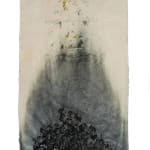Jessica Stockholder USA, b. 1959
Untitled (Kathmandu Residency 030), 2019
Hand-made Nepali lokta paper, found material
54 x 39 3/8 in
137 x 100 cm
137 x 100 cm
7638
Further images
It would be inaccurate to call Jessica Stockholder’s new series of sculptural paper pieces “works on paper.” It’s more like the paper is the work. Stockholder created the series during...
It would be inaccurate to call Jessica Stockholder’s new series of sculptural paper pieces “works on paper.” It’s more like the paper is the work. Stockholder created the series during a residency in Kathmandu, the capital city of Nepal, in late autumn of 2019. One part of Stockholder’s Kathmandu Projects residency was hosted at a traditional paper-making facility located on a hillside overlooking the city, where paper is made from the fibrous inner bark of lokta, a type of local evergreen plant also known as Daphne. The methods and tools employed there are ancient and traditional, or as Stockholder calls them, “rough and ready,” meaning the artists are able to engage personally and directly in every stage of the paper making process.
“The paper making is done mostly outside,” Stockholder explains. “The fibers are soaked, beaten and bleached, in the end turning into a pulp that is mixed with water and poured over a screen.”
After the water drains through the screen, a layer of dry paper is left behind. This, however, was only the starting point for Stockholder. Rather than using the paper as a surface support for an artwork, she added fibers, color, and materials into the paper itself, using the paper as glue and embedding locally gathered materials within the fibers.
“Kathmandu is a really crowded city,” Stockholder recalls. “In the wake of a Maoist insurrection that ended around 2006, most of the rural people in Nepal moved to the urban area. The city is in a valley between mountains, so the air is filthy with car fumes, the dust from dirt roads, and with construction dust from all of the buildings going up. When we were driving around, one of the things that struck me is the enormous number of wires running everywhere—internet wires, phone wires, power wires. There are many electrical poles that are just tangled bushes of wires. And there are wires all over the ground. So, we collected a whole bunch of the old wires, which are included in some of the paper pieces. I also went shopping and bought dried fish, leaves and some beautiful sari materials to work with.”
Every step of the process required careful attention and flexibility. For example, the water used for soaking the pulp is held in pits dug in the ground, so if different colors of dye were to be used, Stockholder first had to account for the fact that the water could not be drained or cleaned in between treatments. The colors accumulating in the water needed to be made use of. Stockholder enjoyed the challenge of making due with what was on offer, and felt at home as she experimented in this environment.
“Yielding total control—that is quite fluid with my work generally. Nothing much happens unless I do that,” she says.
“The paper making is done mostly outside,” Stockholder explains. “The fibers are soaked, beaten and bleached, in the end turning into a pulp that is mixed with water and poured over a screen.”
After the water drains through the screen, a layer of dry paper is left behind. This, however, was only the starting point for Stockholder. Rather than using the paper as a surface support for an artwork, she added fibers, color, and materials into the paper itself, using the paper as glue and embedding locally gathered materials within the fibers.
“Kathmandu is a really crowded city,” Stockholder recalls. “In the wake of a Maoist insurrection that ended around 2006, most of the rural people in Nepal moved to the urban area. The city is in a valley between mountains, so the air is filthy with car fumes, the dust from dirt roads, and with construction dust from all of the buildings going up. When we were driving around, one of the things that struck me is the enormous number of wires running everywhere—internet wires, phone wires, power wires. There are many electrical poles that are just tangled bushes of wires. And there are wires all over the ground. So, we collected a whole bunch of the old wires, which are included in some of the paper pieces. I also went shopping and bought dried fish, leaves and some beautiful sari materials to work with.”
Every step of the process required careful attention and flexibility. For example, the water used for soaking the pulp is held in pits dug in the ground, so if different colors of dye were to be used, Stockholder first had to account for the fact that the water could not be drained or cleaned in between treatments. The colors accumulating in the water needed to be made use of. Stockholder enjoyed the challenge of making due with what was on offer, and felt at home as she experimented in this environment.
“Yielding total control—that is quite fluid with my work generally. Nothing much happens unless I do that,” she says.







